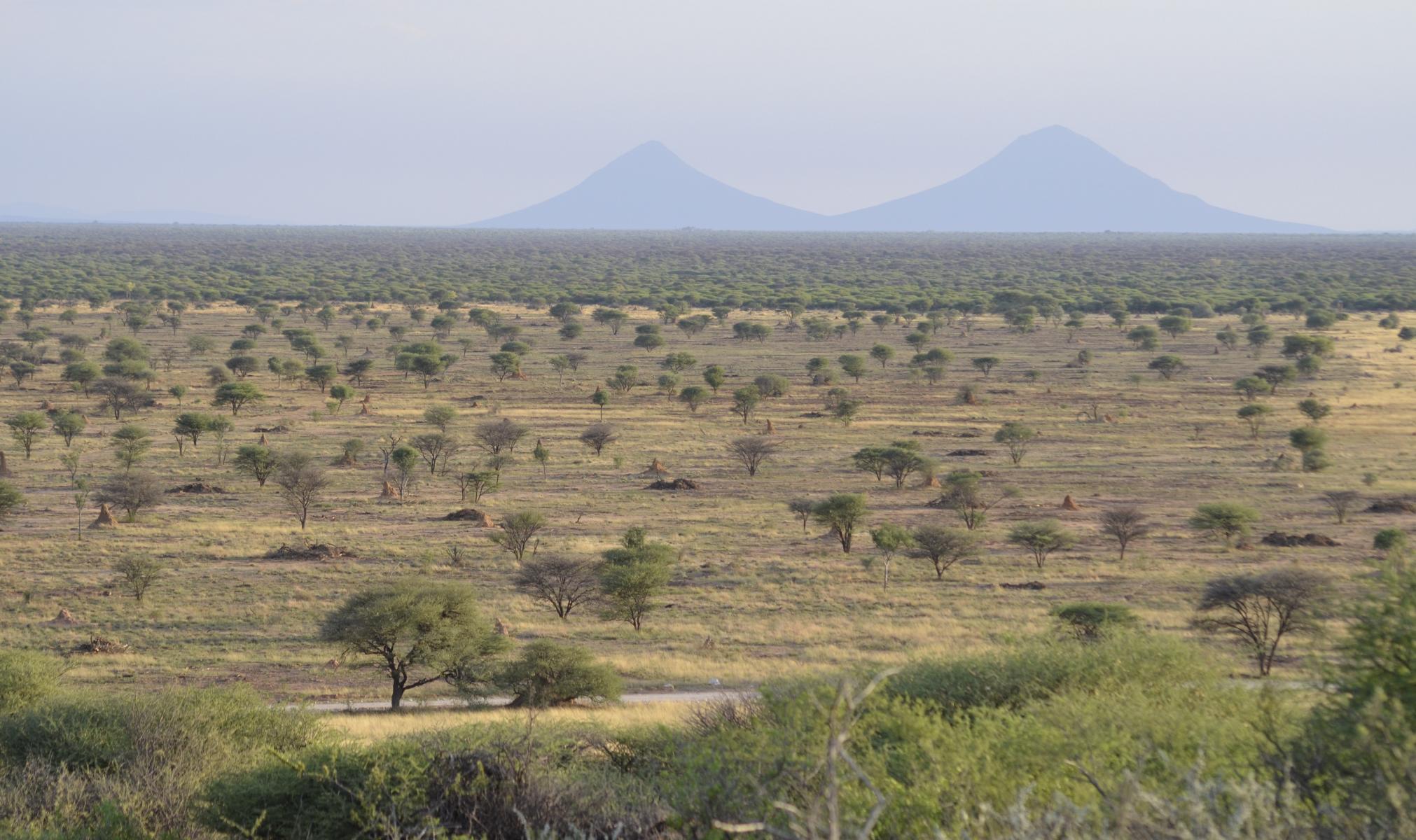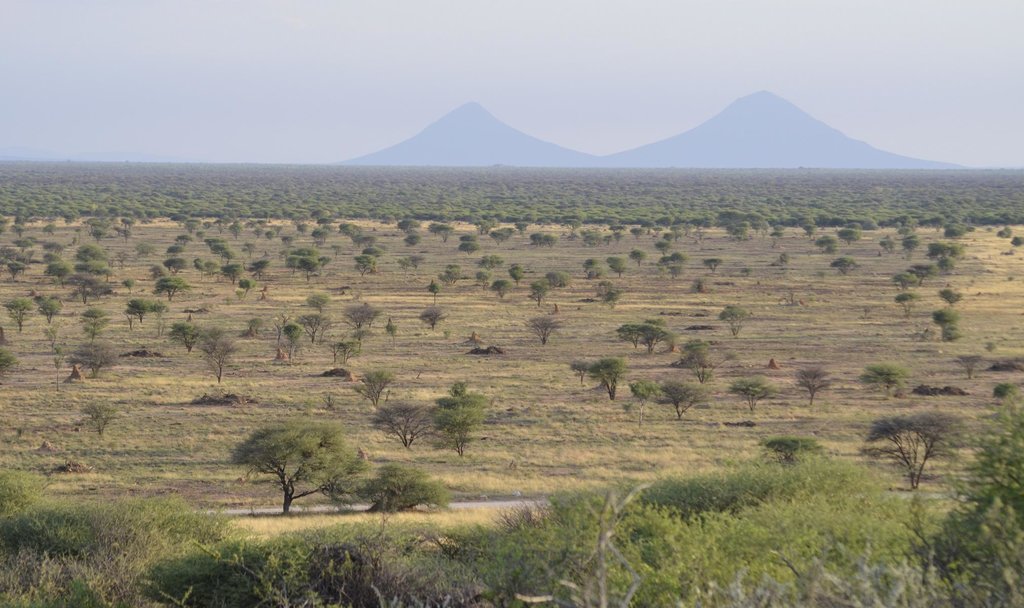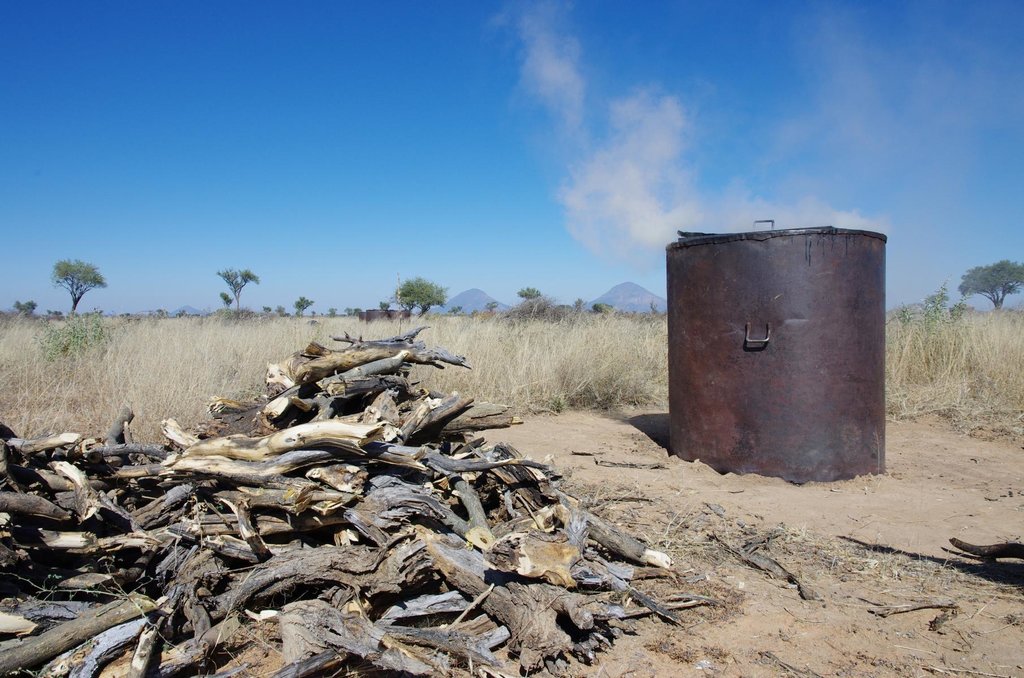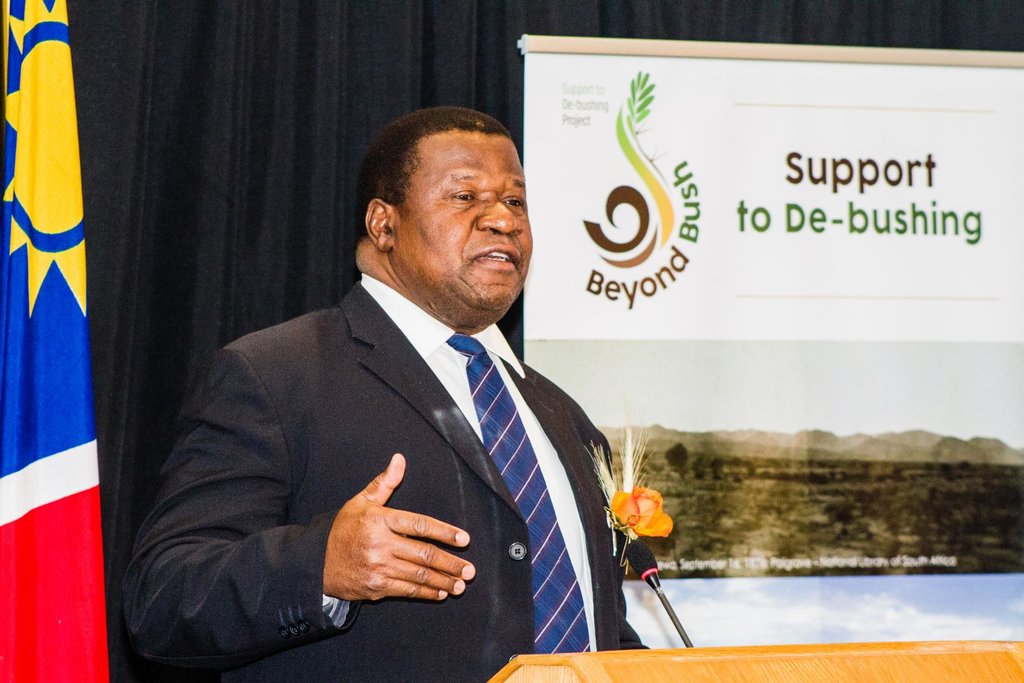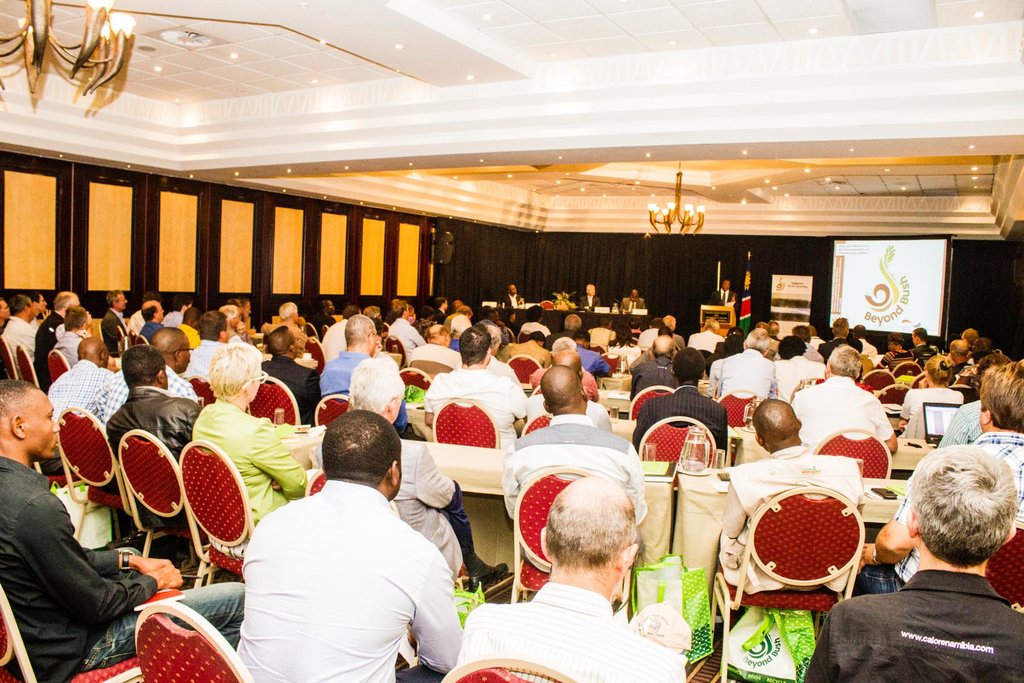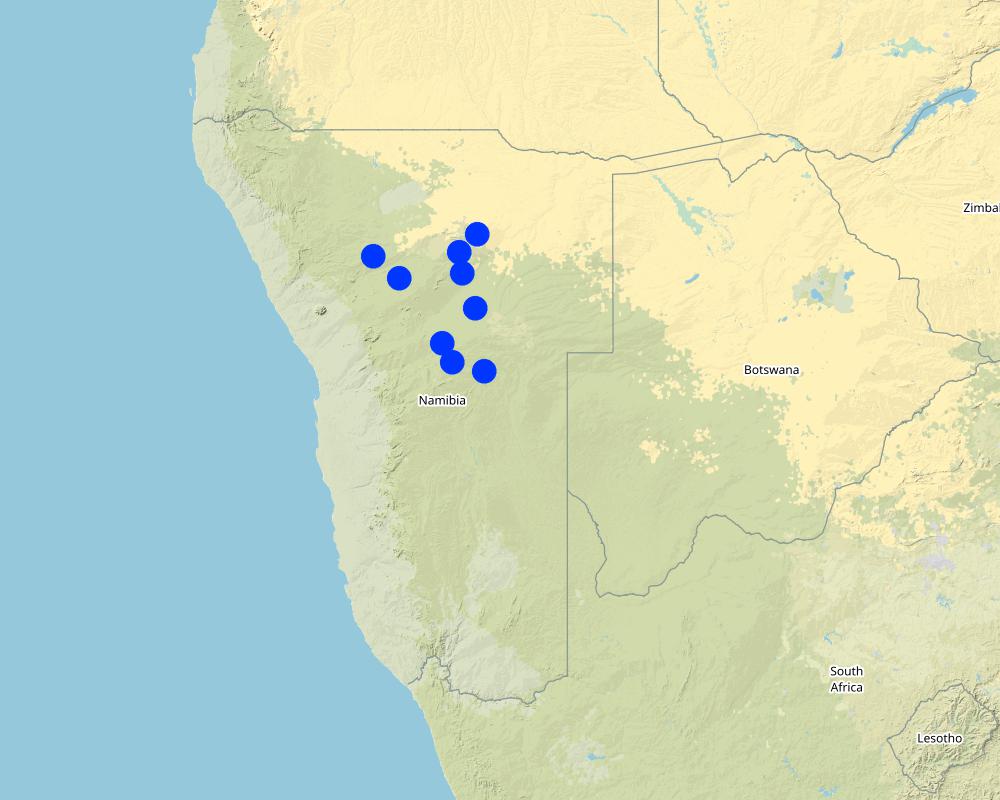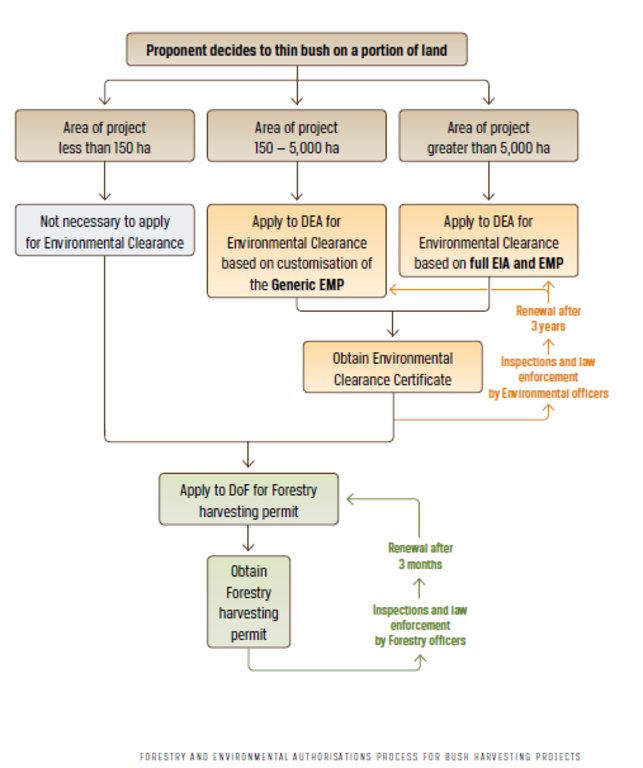Bush Control and Biomass Utilisation [Namíbia]
- Criação:
- Atualização:
- Compilador/a: Johannes Laufs
- Editor: Asellah David
- Revisores: Rima Mekdaschi Studer, Joana Eichenberger
Bush Control and Biomass Utilisation
approaches_2809 - Namíbia
Veja as seções
Expandir tudo Recolher tudo1. Informação geral
1.2 Detalhes do contato das pessoas capacitadas e instituições envolvidas na avaliação e documentação da abordagem
Especialista em GST:
Gschwender Frank
frank.gschwender@giz.de
Deutsche Gesellschaft für Internationale Zusammenarbeit (GIZ)
Nome do projeto que facilitou a documentação/avaliação da Abordagem (se relevante)
GIZ Support to De-bushing ProjectNome do projeto que facilitou a documentação/avaliação da Abordagem (se relevante)
Book project: Guidelines to Rangeland Management in Sub-Saharan Africa (Rangeland Management)Nome da(s) instituição(ões) que facilitou(ram) a documentação/avaliação da Abordagem (se relevante)
Deutsche Gesellschaft für Internationale Zusammenarbeit (GIZ)1.3 Condições em relação ao uso da informação documentada através de WOCAT
Quando os dados foram compilados (no campo)?
01/06/2015
O compilador e a(s) pessoa(s) capacitada(s) aceitam as condições relativas ao uso de dados documentados através do WOCAT:
Sim
2. Descrição da abordagem de GST
2.1 Descrição curta da abordagem
Public and private stakeholders in Namibia are cooperating in the national Bush Control and Biomass Utilisation programme. There are three components: (1) Creation of an enabling framework, (2) Advisory Services and (3) Value Chain Development.
2.2 Descrição detalhada da abordagem
Descrição detalhada da abordagem:
Namibia is affected by bush encroachment on a massive scale: it affects some 45 million hectares in 9 of the 14 regions. Bush encroachment has lowered the carrying capacity of rangeland by up to two thirds. It further severely reduces biodiversity and limits the recharge of groundwater.
Various factors contribute to the acceleration of bush encroachment. A primary cause is overgrazing: the grass layer loses its competitive advantage and greater infiltration of water and nutrients into the sub-soil results, benefiting bush and tree species. Other factors are the reduction in the frequency of wildfires, and the exclusion of wildlife browsers through fencing for livestock.
The “state-and-transition model” describes how savannah ecosystems are event-driven, where rainfall variation impacts on vegetation growth and its composition. Woody plants establish themselves after dry periods followed by a few wet years, and then maintain themselves by utilizing most of the water. But a savannah can be changed back to its grass-dominated state by management or favorable environmental conditions.
Bush encroachment is accompanied by the loss of perennial grasses, which are replaced by annuals of inferior quality and productivity – thus livestock production becomes precarious and less sustainable.
Despite its negative impacts, the encroaching bush has developed into a huge surplus biomass resource, estimated at about 200 to 300 million tonnes. Measures used to combat bush encroachment create positive opportunities for the Namibian economy, such as the use of the resource for power generation and value chain development in other sectors.
Bush harvesting therefore offers the potential to increase economic growth, employment and energy security, while benefiting agriculture and food production.
In line with national development plans, which promote domestic value addition for local resources, the approach strengthens the restoration of productive rangeland. It triggers and drives large-scale bush thinning activities.
The programme will foster institutional development in the biomass sector and provide support to improve the legal and regulatory framework for the upscaling of bush control. It has three components:
(1) Creation of an enabling framework: harmonization of sector policies and improvement of relevant regulations; strengthening of institutional capacities.
(2) Advisory Services: strengthening of existing farmer outreach services and knowledge dissemination to farmers, businesses and public sector decision makers.
(3) Value Chain Development: identification and piloting of relevant value chains for encroacher bush as a trigger for bush control.
It is implemented through a collaboration of public and private stakeholders. Coordination is ensured through a cross-sector steering committee, which includes the Ministries of National Planning (chair), Agriculture, Environment, Energy, and Industrialisation.
Key outputs of the programme include:
Enabling Environment:
- Strategic Environmental Assessment (SEA)
- Introduction of Harvesting Authorisations Guidelines
- Development of dedicated financial products (loan subsidy schemes).
Institutions:
- Introduction of the De-bushing Advisory Service (DAS)
- Introduction of the Namibia Biomass Industry Group (N-BiG)
- Re-organisation of the Namibia Charcoal Association (NCA).
Knowledge:
- Compilation of baseline data on bush encroachment and bush control
- Technical know-how on value chain technologies and concepts
- Compilation of relevant regulations and environmental principles.
Value Chain Development:
- Piloting of various value chains, including modernized charcoal production, bush based animal feed and household cooking fuel.
2.3 Fotos da abordagem
2.5 País/região/locais onde a abordagem foi aplicada
País:
Namíbia
Região/Estado/Província:
Bush control is applied across Namibia on many privately owned farms. Activities are most concentrated in the regions of Khomas, Omaheke, Otjozondjupa and Oshikoto.
Especificação adicional de localização:
Pointers indicate hotspots (e.g. urban centres) around which activities are concentrated. It is not possible to depict each site where bush control is implemented due to the high number of individual activities and because no GIS based mapping has been conducted.
Map
×2.6 Datas de início e término da abordagem
Indique o ano de início:
2014
Caso o ano exato seja desconhecido, indique a data aproximada de início da abordagem:
menos de 10 anos atrás (recentemente)
Ano de término (caso a abordagem não seja mais aplicada):
2021
2.7 Tipo de abordagem
- Baseado em projeto/programa
2.8 Principais metas/objetivos da abordagem
Develop, test and upscale the implementation of bush control technologies in Namibia.
2.9 Condição que propiciam ou inibem a implementação de tecnologia/tecnologias aplicada(s) segundo a abordagem
Normas e valores sociais/culturais/religiosos
- Propício
Awareness of the need to implement bush control across all stakeholder groups.
- Inibitivo
Low level of cooperation and information exchange.
Disponibilidade/acesso a recursos e serviços financeiros
- Inibitivo
Limited variety of dedicated/customized financial products available; cost of finance high.
Quadro institucional
- Inibitivo
Low level of cross-sector coordination and limited funding sources for sector representative bodies (e.g. associations).
Colaboração/coordenção de atores
- Inibitivo
Low level of interaction and knowledge sharing.
Quadro jurídico (posse de terra, direitos de uso da terra e da água)
- Propício
Clear land tenure in commercial areas and suitable concepts in communal areas (e.g. conservancies and community forests).
Políticas
- Inibitivo
Low level of policy harmonization across sectors; need to resolve conflicting mandates of relevant authorities (e.g. industrialization vs. resource protection).
Governança da terra (tomada de decisões, implementação e aplicação)
- Propício
Clear governance and management in commercial areas.
- Inibitivo
Unclear decision-making processes for income generating projects in communal areas.
Conhecimento sobre GST, acesso a suporte técnico
- Inibitivo
Low level of bush control know how among land owners.
Mercados (para comprar entradas, vender produtos) e preços
- Propício
High national and international demand for woody products.
Carga de trabalho, disponibilidade de força de trabalho
- Inibitivo
Low level of skills among workers.
3. Participação e papel das partes interessadas envolvidas
3.1 Partes interessadas envolvidas na abordagem e seus papéis
- Usuários de terra/comunidades locais
Commercial farmers, communal farmers, conservancies
Implementation of bush control and/or availing land for bush control and biomass utilisation activities
- Organizações comunitárias
conservancies, community forests
Implementation of bush control and/or availing land for bush control and biomass utilisation activities
- Especialistas em GST/ consultor agrícola
Farmer outreach services and independent experts
Dissemination of information and skills development
- Pesquisadores
Namibia University of Science (NUST), University of Namibia (UNAM)
Complementary research projects
- Setor privado
Namibia Biomass Industry Group (N-BiG), Namibia Charcoal Association (NCA)
Representation of corporates involved in bush harvesting and biomass value addition.
- Governo nacional (planejadores, responsáveis pelas decisões)
National Planning Commission (NPC)
Ministry of Agriculture, Water and Forestry (MAWF)
Ministry of Environment and Tourism (MET)
Ministry of Mines and Energy (MME)
Ministry of Industrialisation and SME Development (MITSMED)
Policy and strategy development; sector steering; law enforcement, monitoring and evaluation.
- Organização internacional
Deutsche Gesellschaft für Internationale Zusammmenarbeit (GIZ), KfW, EIB, UNDP
Implementation of bilateral cooperation projects
3.2 Envolvimento do usuários de terra/comunidades locais nas diferentes fases da abordagem
| Envolvimento do usuários de terra/comunidades locais | Especifique quem estava envolvido e descreva as atividades | |
|---|---|---|
| Iniciação/motivação | Automobilização | High awareness and mobilisation within the farming community. |
| Planejamento | Participativo | Good participation in public workshops and conferences. |
| Implementação | Automobilização | Implementation of bush control by individual farmers. |
| Monitoramento/avaliação | Passivo | Very limited monitoring and evaluation through individual land owners. |
3.3 Fluxograma (se disponível)
Descrição:
Legal and regulatory framework for large scale bush control: the flow chart explains the three levels of categories for the Environmental Clearance process. The categories are as follows:
- Small bush harvesting operations covering less than 150 ha: no environmental clearance required
- Medium bush harvesting operations covering between 150 and 5 000 ha: environmental clearance based on a generic Environmental Management Plan (EMP) is needed
- Large bush harvesting operations of more than 5 000 ha, Environmental Clearance based on Environmental Impact Assessment (EIA) and Environmental Management Plan (EMP)
Abbreviations:
DEA - Directorate of Environmental Affairs, Ministry of Environment and Tourism
DoF - Directorate of Forestry, Ministry of Agriculture, Water and Forestry
EIA - Environmental Impact Assessment
EMP - Environmental Management Plan
ha - hectares
Autor:
GIZ Support to De-bushing Project (2016)
3.4 Decisão sobre a seleção de tecnologia/tecnologias de GST
Especifique quem decidiu sobre a seleção de tecnologia/tecnologias a serem implementadas:
- todos os atores relevantes, como parte de uma abordagem participativa
Especifique em que base foram tomadas as decisões:
- Avaliação de conhecimento bem documentado de GST (tomada de decisão baseada em evidências)
- Resultados de pesquisa
- Experiência pessoal e opiniões (não documentado)
4. Suporte técnico, reforço das capacidades e gestão do conhecimento
4.1 Reforço das capacidades/formação
Foi oferecida formação aos usuários da terra/outras partes interessadas?
Sim
Especifique quem foi capacitado:
- Equipe de campo/consultores
Tipo de formação:
- Em exercício
- Áreas de demonstração
- Reuniões públicas
Assuntos abordados:
- Environmental and forestry policy and policy emplementation (training for government officials from regional offices)
- Implementation of bush control and biomass processing (training for farmers and SMEs)
4.2 Serviço de consultoria
Os usuários de terra têm acesso a um serviço de consultoria?
Sim
Especifique se foi oferecido serviço de consultoria:
- Em centros permanentes
Descreva/comentários:
Advisory services through the De-bushing Advisory Service (DAS, www.dasnamibia.org)
4.3 Fortalecimento da instituição (desenvolvimento organizacional)
As instituições foram fortalecidas ou estabelecidas através da abordagem?
- Sim, significativamente
Especifique a que nível (níveis) as instituições foram fortalecidas ou estabelecidas:
- Nacional
Descreva instituição, papéis e responsabilidades, membros, etc.
Launch of
- De-bushing Advisory Service (DAS)
- Namibia Biomass Industry Group (N-BiG)
Re-organisation of
- Namibia Charcoal Association (NCA)
Especifique o tipo de apoio:
- Financeiro
- Reforço das capacidades/formação
- Equipamento
- Institutional Development
Dê mais detalhes:
Three sector institutions have been supported in order to achieve increased coordination of efforts. The Namibia Biomass Industry Group (N-BiG) is a non-profit association, representing the interest of bush harvesting and processing companies. The De-bushing Advisory Service (DAS) is a national platform for the dissemination of knowledge on the topics of bush encroachment, bush control and biomass utilisation.
The Namibia Charcoal Association (NCA) represents the already well established charcoal production sector. Through a re-organisation process, the association has been strengthended and turned into a fully functioning sector representation.
The three organisations are planned to consolidate their efforts in the near future in order to achieve a better alignment of their mandates and synergies of activities.
4.4 Monitoramento e avaliação
Monitoramento e avaliação são partes da abordagem?
Sim
Comentários:
National Bush Information System
- Scope of bush encroachment
- Scope of bush control activities
- Success rate of bush control methodologies, incl. secondary impacts (employment)
Caso afirmativo, esta documentação é destinada a ser utilizada para monitoramento e avaliação?
Não
4.5 Pesquisa
A pesquisa foi parte da abordagem?
Sim
Especifique os tópicos:
- Economia/Marketing
- Ecologia
- Tecnologia
Dê mais detalhes e indique quem realizou a pesquisa:
Collaboration with scientific institutions and networks on:
- Identification and development of suitable technology
- Correlation with ecosystem services, e.g. grounwater recharge and biodiversity
- Identification of market for bush based products.
5. Financiamento e apoio material externo
5.1 Orçamento anual para o componente de GST da abordagem
Caso o orçamento exato seja desconhecido, indique a faixa:
- > 1.000.000
Comentários (p. ex. principais fontes de recursos/principais doadores):
Pooling of resources between national government, international donors and private sector.
5.2 Apoio financeiro/material concedido aos usuários da terra
Os usuários da terra receberam apoio financeiro/material para a implementação de tecnologia/tecnologias?
Não
5.3 Subsídios para entradas específicas (incluindo mão-de-obra)
- Nenhum
Se a mão-de-obra pelos usuários da terra foi uma entrada substancial, isso foi:
- Voluntário
5.4 Crédito
Foi concedido crédito segundo a abordagem para atividades de GST?
Sim
Especifique as condições (taxa de juros, reembolso, etc):
Commercial loans with grace period of up to 3 years and interest rate of 7-8%.
Especifique os fornecedores de crédito:
Commercial banks: First National Bank (FNB), Agribank
Development Bank of Namibia (DBN)
Environmental Investment Fund (EIF).
Especifique os destinatários do crédito:
- Individual households/farmers
- Service providers/business
5.5 Outros incentivos ou instrumentos
Foram utilizados outros incentivos ou instrumentos para promover a implementação das tecnologias de GST?
Sim
Caso afirmativo, especifique:
Development of authorisations guidelines and review of regulations with regard to Environmental Management Plans (EMPs) and Environmental Impact Assessments (EIAs).
6. Análise de impactos e declarações finais
6.1 Impactos da abordagem
A abordagem concedeu autonomia aos usuários locais de terra, melhorou a participação das partes interessadas?
- Não
- Sim, pouco
- Sim, moderadamente
- Sim, significativamente
Increased dissemination of information and exchange between land users on experiences with technologies; stakeholder representation through associations and participation in high level national conferences.
A abordagem propiciou a tomada de decisão baseada em evidências?
- Não
- Sim, pouco
- Sim, moderadamente
- Sim, significativamente
Various publications to capture best practices in bush control and biomass utilisation, including farmers manuals.
A abordagem auxiliou os usuários da terra a implementar e manter as tecnologias de GST?
- Não
- Sim, pouco
- Sim, moderadamente
- Sim, significativamente
Development of various guidelines
A abordagem melhorou a coordenação e a implementação economicamente eficiente da GST?
- Não
- Sim, pouco
- Sim, moderadamente
- Sim, significativamente
Improvement of cross-sector collaboration through steering committee.
A abordagem mobilizou/melhorou o acesso aos recursos financeiros para implementação da GST?
- Não
- Sim, pouco
- Sim, moderadamente
- Sim, significativamente
Involvement of financial institutions with the aim to develop customised financial products.
A abordagem aprimorou o conhecimento e as capacidades dos usuários da terra para implementar a GST?
- Não
- Sim, pouco
- Sim, moderadamente
- Sim, significativamente
Various publications to capture best practices in bush control and biomass utilisation, including farmers manuals.
A abordagem aprimorou o conhecimento e as capacidades de outras partes interessadas?
- Não
- Sim, pouco
- Sim, moderadamente
- Sim, significativamente
Increase awareness of the opportunity of the biomass resource among public sector stakeholders as well as within the business community.
A abordagem construiu/fortaleceu instituições, colaboração entre partes interessadas?
- Não
- Sim, pouco
- Sim, moderadamente
- Sim, significativamente
Through introduction of steering committee, working groups as well as through the strengthening of sector representative bodies/associations.
A abordagem concedeu autonomia aos grupos social e economicamente desfavorecidos?
- Não
- Sim, pouco
- Sim, moderadamente
- Sim, significativamente
Employment creation in bush control and biomass utilisation, e.g. in charcoal production.
A abordagem melhorou a igualdade de gêneros e concedeu autonomia a mulheres e meninas?
- Não
- Sim, pouco
- Sim, moderadamente
- Sim, significativamente
Promotion of dedicated employment opportunities for women, e.g. in charcoal packaging.
A abordagem resultou em acesso melhorado à água e ao saneamento?
- Não
- Sim, pouco
- Sim, moderadamente
- Sim, significativamente
Improved groundwater recharge in bush controlled areas. Research is ongoing and first results indicate a significantly improved infiltration of rainwater into the groundwater. The reduced number of bushes leads to reduced evapotranspiration.
A abordagem resultou em uso/fontes de energia mais sustentável?
- Não
- Sim, pouco
- Sim, moderadamente
- Sim, significativamente
First biomass energy projects launched (industrial heating) and in preparation (national grid electricity production).
A abordagem resultou em emprego, oportunidades de renda?
- Não
- Sim, pouco
- Sim, moderadamente
- Sim, significativamente
Employment in bush harvesting and processing, especially in charcoal production.
6.2 Principal motivação dos usuários da terra para implementar a GST
- Produção aumentada
Need for bush control in order to increase carrying capacity of land.
- Degradação do solo reduzida
Rehabilitation of land through bush thinning.
6.3 Atividades de sustentabilidade de abordagem
Os usuários da terra podem manter o que foi implementado através da abordagem (sem apoio externo)?
- Sim
Caso afirmativo, descreva como:
Land users have the capacity to implement bush control, either with own means (mainly manual and semi-mechanised bush harvesting) or through the involvement of service providers (mainly fully mechanised bush harvesting for the supply of large-scale off-takers).
6.4 Pontos fortes/vantagens da abordagem
| Pontos fortes/vantagens/oportunidades na visão do usuário da terra |
|---|
| Financial viability of bush control through the introduction of value chains (as compared to mere removal of the biomass). |
| Improved access to information and know how. |
| Improved advocacy/ communication with government authorities. |
| Pontos fortes/vantagens/oportunidades na visão do compilador ou de outra pessoa capacitada |
|---|
| Mindshift among public and decision makers from focus on the challenge (bush encroachment) to the opportunities (value addition). |
| Cross-sector cooperation through steering committee. |
| Involvement of private sector as driving force for implementation. |
6.5 Pontos fracos, desvantagens da tecnologia e formas de superá-los
| Pontos fracos/desvantagens/riscos na visão do usuário da terra | Como eles podem ser superados? |
|---|---|
| Limited direct (financial) support. | Introdution of incentive schemes. |
| Limited opportunities in remote areas, i.e. when distance to biomass off-takers is too large. | Further development of on-farm solutions (e.g. bush-to-feed). |
| Pontos fracos/vantagens/riscos na visão do compilador ou de outra pessoa capacitada | Como eles podem ser superados? |
|---|---|
| Complex programme steering requirements, due to multi-sector relevance. The national programme for Bush control and Biomass Utilisation is currently anchored in the Directorate of Forestry (DoF) of the Ministry of Agriculture. This adequately accounts for the fact that the bush resource is part of the national forestry/biomass resource and its utilisation must be regulated as such. However, this anchoring does not allow for an effective promotion of biomass utilisation (e.g. SME promotion, industrialisation concepts, development of logistics hubs) and innovative end-uses (e.g. development of biomass power plants). For this purpose other line ministries, such as Ministry of Mines and Energy (MME) as well as Ministry of Industrialisation and SME Development (MITSMED) are part of the programme's steering committee. | Establishment of national coordinating body to formalise the current steering committee. |
7. Referências e links
7.1 Métodos/fontes de informação
- entrevistas com usuários de terras
- entrevistas com especialistas em GST
7.2 Referências às publicações disponíveis
Título, autor, ano, ISBN:
Baseline Assessment for the De-bushing Programme in Namibia (2014)
Disponível de onde? Custos?
GIZ Support to De-bushing Project, www.dasnamibia.org/downloads
Título, autor, ano, ISBN:
GIZ Support to De-bushing Project (2016)
Disponível de onde? Custos?
Strategic Environmental Assessment of Large-Scale Bush Thinning and Value Addition Activities in Namibia, www.dasnamibia.org/downloads
7.3 Links para informação relevante que está disponível online
Título/ descrição:
De-bushing Advisory Service (DAS) Namibia, Resource Section
URL:
www.dasnamibia.org/downloads
Título/ descrição:
Namibia Biomass Industry Group (N-BiG)
URL:
www.n-big.org
Título/ descrição:
Namibia Charcoal Association (NCA)
URL:
www.ncanamibia.com
Links e módulos
Expandir tudo Recolher tudoLinks
Não há links
Módulos
Não há módulos


